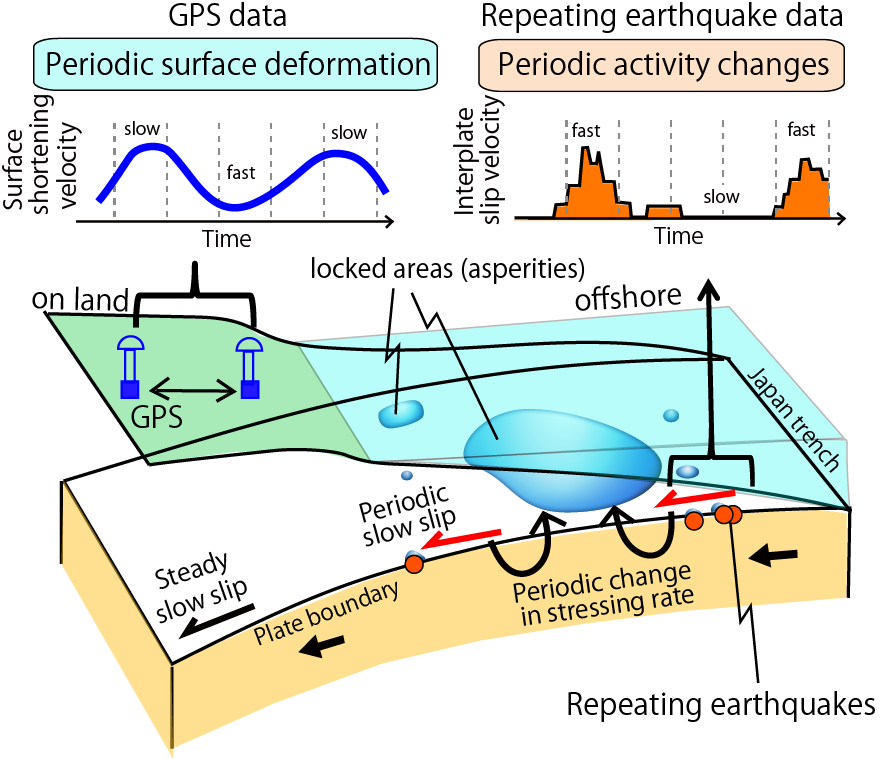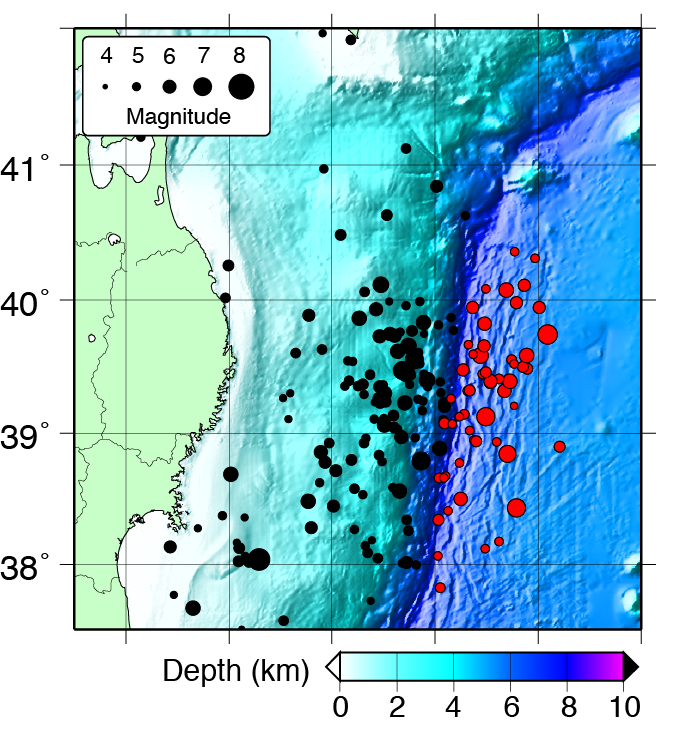Periodic slow slip triggers megathrust zone earthquakes in northeastern Japan
Uchida, N., T. Iinuma, R. M. Nadeau, R. Bürgmann, and R. Hino, Periodic slow slip triggers megathrust zone earthquakes in northeastern Japan, Science, 351(6272), 488-492, doi:10.1126/science.aad3108, 2016.
Both aseismic and seismic slip accommodate relative motion across partially coupled plate boundary faults. In northeastern Japan, aseismic slip occurs in the form of decelerating afterslip following large interplate earthquakes and as relatively steady slip on uncoupled areas of the subduction thrust. Here we report on a new quasi-periodic slow-slip behavior that is widespread in the megathrust zone. The repeat intervals of the slow slip range from 1 to 6 years and often coincide with or precede clusters of large (M ≥ 5) earthquakes, including the M9 Tohoku-oki earthquake. These results suggest that inherently periodic slow-slip events result in periodic stress perturbations and modulate the occurrence time of larger earthquakes. The periodicity in the slow-slip rate has the potential to help refine time-dependent earthquake forecasts.
Figure: Schematic figure showing data, results and interpretations of this paper. We used repeating earthquake and GPS data to infer offshore quasi-periodic interplate slip. The offshore repeater data provided direct evidence for periodic change in interplate slow-slip velocity from their periodic activity changes. The on-land GPS data show surface deformations correlated with the offshore periodic slow-slip. The slow-slips cause periodic changes in stressing rate to locked areas on the megathrust and thus modulate the occurrence time of large earthquakes.
-----------------------------------------------------------
Figure: Schematic figure showing data, results and interpretations of this paper. We used repeating earthquake and GPS data to infer offshore quasi-periodic interplate slip. The offshore repeater data provided direct evidence for periodic change in interplate slow-slip velocity from their periodic activity changes. The on-land GPS data show surface deformations correlated with the offshore periodic slow-slip. The slow-slips cause periodic changes in stressing rate to locked areas on the megathrust and thus modulate the occurrence time of large earthquakes.
-----------------------------------------------------------
The great 1933 Sanriku-oki earthquake: reappraisal of the mainshock and its aftershocks
Uchida, N., S. Kirby, N. Umino, R. Hino, and T. Kazakami, The great 1933 Sanriku-oki earthquake: reappraisal of the mainshock and its aftershocks and implications for its tsunami using regional tsunami and seismic data, Geophys. J. Int., 206, 1619-1633, 2016.
The great Sanriku-oki earthquake of 2 March 1933 is the largest earthquake that has recognized to date in the outer-rise/outer-trench-slope region of the Earth and its devastating tsunami led to more than 3000 fatalities. Our findings are largely based on seismic and tsunami observations in Japan and they indicate that it represented relatively complex ruptures including shallow outer-trench compound faulting and triggered interplate seismicity. These results are also supported by a number of geophysical and geomorphological data. Our study has brought new insights into the deformation style earthquakes in the shallow off-trench region and the nearby megathrust zone.
Figure: Three months relocated aftershocks plotted on the bathymetry.
-----------------------------------------------------------
[paper]
Figure: Three months relocated aftershocks plotted on the bathymetry.
-----------------------------------------------------------
[paper]

